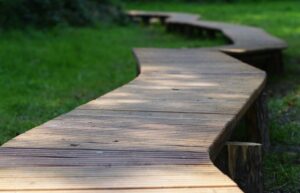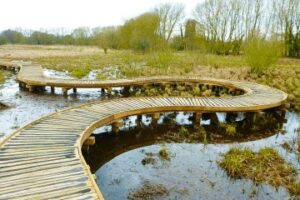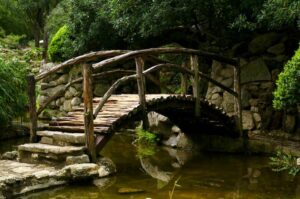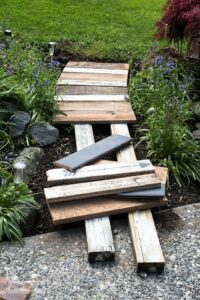Because wood can be so readily cut and joined, and can last so long on or in the ground, it can be used constructively for paving any number of walking surfaces; steps, stairs, boardwalks, footbridges, or ramps. The wood can echo the texture and color of sidings, decks, and outdoor furniture adding coherence to the garden.
Wood is generally used to create geometric shapes. It can introduce bold or simple, straight, angular, or broadly curving lines. It can be raised above with hidden supports and made to appear as if it were floating in what is known as a wooden boardwalk.
But even the hardest of woods will not last forever close to or in the ground. Wood for ground use should be pre-treated with a wood preservative and requires frequent maintenance and periodic replacement.
A simple wooden walk is not difficult not too expensive to build. This is a 1 to 3-day project on a friendly budget.
Wood walkway ideas
Because wood has an informal look, it is inappropriate near a formal home, where cut stone or concrete pavers are preferable. But it is appropriate near beach houses or unpainted rural homes in the woods.
One quality of wood, a quality possessed by no other material, is that it can be painted, thereby introducing color into the garden.
If you live in a brick, stone, or painted wooden house, painted wood can create a formal set of stairs and a landing pad to the front door. Meanwhile, unpainted boardwalks or bridges are best used further away from the house.
But whatever wood is used has to appear functional. Its primary role as a paving material in the garden is to lift you above a surface you would not want to or be able to walk on (water, sand, rough terrain) or to create steps and stairs.
- Boardwalks can cross over boggy areas or shallow water; over sand from a beach house to the main house or from the main house to the beach.
- A small wooden footbridge can be built flat, angled, or slightly arched; close to water or held high above the water in stilts; with or without a bench set into one side; sod covered; over swales or dips in the land or over streams or brooks.
- Steps or stairs, perhaps as risers with brick, cut stone, gravel, or lawn treads.
- For a wooden stile
- Decking or landings that act like stepping stones, or that swells out from connected boardwalks to form a raised patio.
- Free-form ramps from the driveway to the front door
- A covered walkway through sections of the garden
Wooden Boardwalks
If you have a boggy area, visitors can take a boardwalk that acts like a natural trail through boggy wetlands.
A wooden boardwalk is practical, in harmony with the woods and that would not be eroded or turned to mud by heavy rains or the spring thaw.
To enhance the feeling that the wooden path is gentle and respectful of the land, notch the edges of the walkway to accept the trunks of trees or even many saplings, a touch that links the boardwalk to the woods visually.
In winter, you can push snow off the surface of the walkway.


Bridges
Wood can also be used to get people across small ponds or boggy areas. Simple bridges can get you over the pond water and the plants that grow within it.
To make the bridge, drive pairs of posts into the boggy soil and then connect them with crosspieces on which you lay stout planks to create a bridge.
The bridge also provides places for plants; at its beginning and far end.


Footbridges
A footbridge can be applied to any gully or drop in your land to bridge the gap.
Rather than building up the soil with backfill and running in danger of creating a variety of drainage problems, you can build a simple even rustic bridge of two logs withboards nailed across them.


Stairs
Wood can help deal with steeply sloping sites.
The stairs provide the framework and also animate the garden; with every step down them, you are offered a new view of the garden.
A long flight of wooden steps in a steep site can be more important than you intend. By putting staircases at the sides and then planting boxwood topiary with large wooden planters at their base, you can lighten a set of steps that might otherwise have looked massive.











Thank you for noting the use of a wood boardwalk in outdoor places for both aesthetic and utilitarian objectives. Have you considered using a wood boardwalk in your landscape design? If so, where would it lead?
To introduce formality in a woodland garden or as a pass over a swampy site